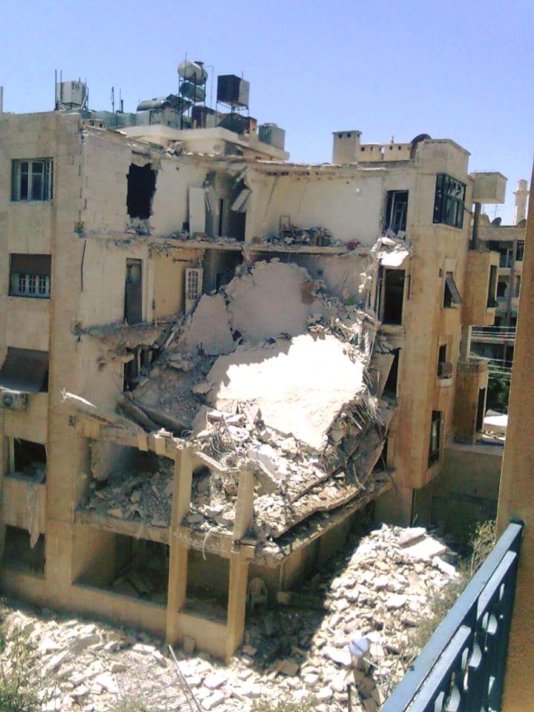- About
- Topics
- Picks
- Audio
- Story
- In-Depth
- Opinion
- News
- Donate
-
Signup for our newsletterOur Editors' Best Picks.Send
Read, Debate: Engage.

| topic: | Health and Sanitation |
|---|---|
| tags: | #enviornment, #Syria, #civil war |
| located: | Syria |
| by: | Jennifer Dathan |
The conflict in Syria has been particularly devastating. Over the last eight years, the use of explosive weapons there, from improvised explosive devices (IEDs) and barrel-bombs, to cluster munitions and bunker-busting missiles, has - according to data collected by Action on Armed Violence (AOAV) - caused at least 79,000 casualties, of which at least 85% (67,000) were civilians.
Such civilian harm, though, is only the tip of an iceberg. Half of Syria’s basic infrastructure lies destroyed or damaged, while explosive remnants of war (ERW) litter the country, continuing to bring harm and inhibiting redevelopment efforts. But whilst the number of casualties caused by landmines and ERW in Syria exists, there is still little data on the scale of the contamination there. What is known is that it is extensive. With ‘layer upon layer upon layer of (explosive violence) contamination’1, some estimates suggest clearance could take up to 50 years.2 Such a prolonged presence of unexploded ordnance across the country brings with it its own deadly guarantee. It will prevent agricultural development, infrastructural rebuild, and will continue to kill and maim civilians and wildlife for years to come.
This cannot be underestimated. In northern Syria, pre-crisis, 70% of the population were said to work in agriculture and livestock 3. Displacement by the violence has led to a loss of skilled workers and a loss of yields – with small-scale farmers impacted the hardest as just one missed harvest can push them into debt and destitution. With such pressure on them, it is of little surprise farmers are among the most common casualties from ERW; they are forced to cultivate contaminated land or face poverty.
But many are forced to make the choice to return to their homes and their land. After the ‘liberation’ of Raqqa, upwards of 50 returnees were killed every week from IEDs and other ERW in the following weeks 4. After a few months, this was to decrease to between 25 and 30 people harmed per week but, as more people return to Syria, casualties are likely to increase again. It is clear that, with over 50% of basic infrastructure in Syria estimated destroyed or damaged, the scale of the clear-up, with all its challenges, is overwhelming 5.
Such damage, alongside the displacement of millions, has caused widespread environmental health risks. Not only has essential infrastructure such as water and energy facilities been damaged but, due to displacement, there are few skilled workers to carry out repairs and general maintenance. In the north, about 60% of water systems were said to be non-functional due to the lack of power supply 6. This reduced access to clean drinking water, as well as the absence of waste-water treatment, has increased rates of water-borne diseases and other sicknesses related to poor hygiene 7.
Mountains of rubble and waste have also created a perfect habitat for sand flies, leading to severe outbreaks of leishmaniasis, where its most common form - cutaneous - causes severe skin lesions, leaving scars and sometimes leading to serious disability. In its other form - visceral – it is often fatal. Findings suggest the rate of leishmaniasis has grown in war-torn Syria by at least 150%8.
The destruction of buildings and the accumulation of rubble may lead to other health impacts. For instance, the wholesale destruction of buildings has released a large number of dangerous and toxic substances into the environment 9. Following the 2001 attacks on the World Trade Center, the sudden release of toxic dust into New York’s atmosphere in part led to over 43,000 people being certified with a 9/11 related health condition, with almost 10,000 having a related cancer. Even today, almost two decades on, cases continue to surface 10.
This was in the US, where the medical infrastructure remained intact after the terror attack. In Syria, a lack of safety equipment in clearance operations, a prolonged and widespread exposure due to uncleared waste, and a lack of health infrastructure will only increase the risks of environmental consequences over the coming years.
Pollution from wastewater, sewage system destruction and bombed-out oil facilities also pose health concerns, not just to humans but to wildlife and livestock. While displaced communities have also been shown to pose a strain on habitats, as scavenging for resources such as firewood has widespread impact.
It is clear that across the board and for generations to come, the environmental harm brought by explosive violence to Syria is likely to have a significant impact, particularly to health and development. Indeed, we are unlikely to understand the full implications of such destruction for many years. Such consequences, though, should be at the forefront of the minds of humanitarian agencies seeking to assist in the redevelopment of Syria – and should equally serve as a stark warning on the long-term harm that explosive weapons invariably bring.
Sources: